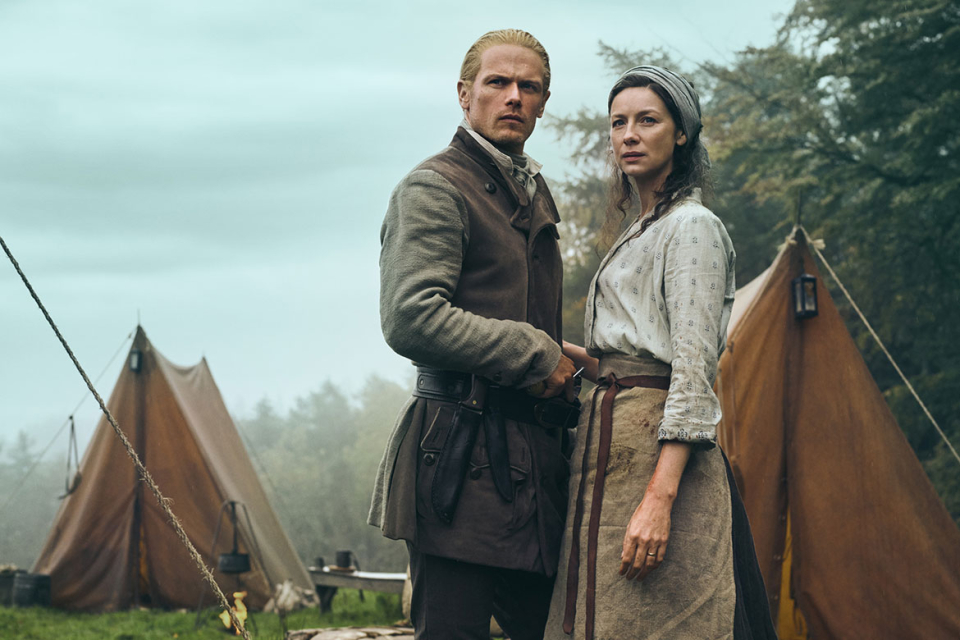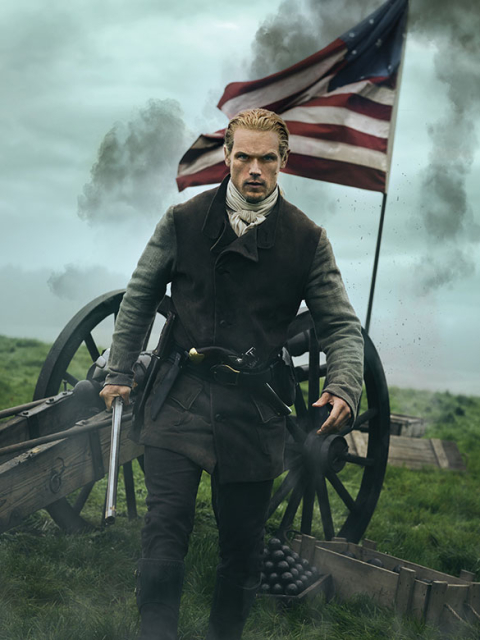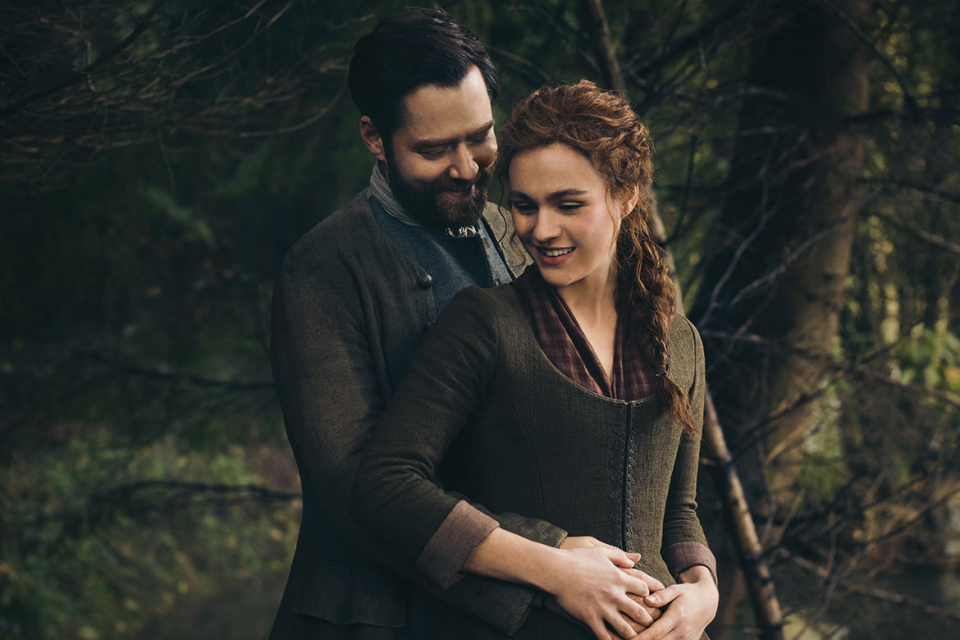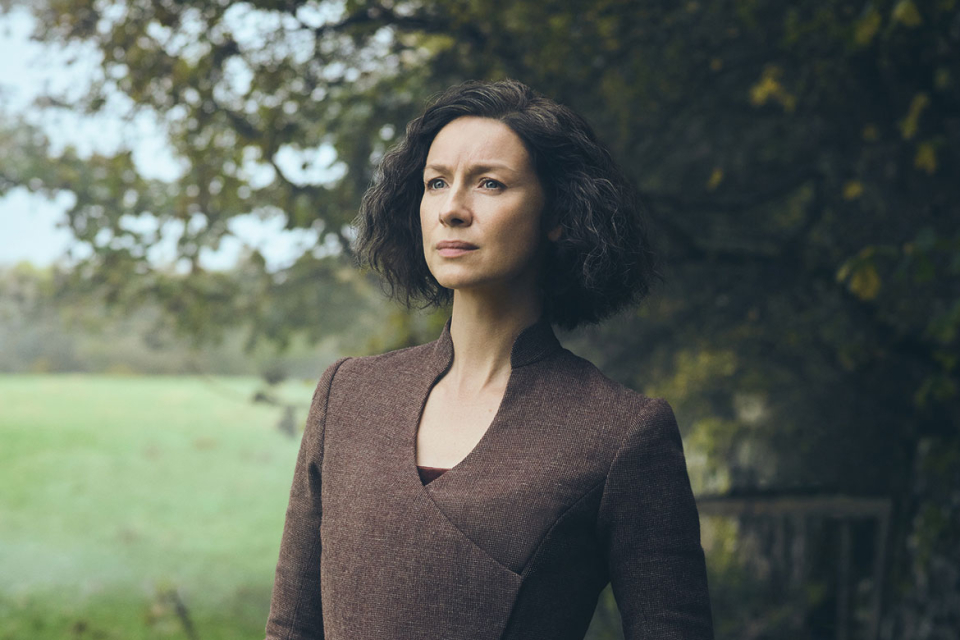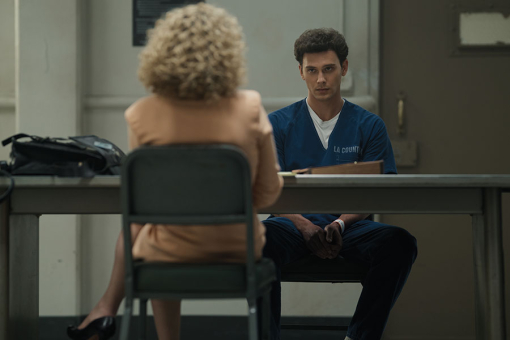As season seven approached, clouds appeared to be hanging over Outlander. But were they fluffy white clouds, or dark and stormy? Showrunner Matthew B. Roberts wasn't sure.
For a decade now, since the worldwide Starz series began production in Scotland in 2013, the producers have had a running joke heading into each season — that this season would finally be the easy one. They wouldn't be on the high seas anymore or traveling as much to different locations. They could shoot on standing sets, with the Fraser family's main characters settled on the Ridge, their home in Colonial America.
Much of the appeal of this genre-busting drama is that each season creates a whole new world. It has spanned continents and centuries, moving back in time from post–World War II Britain to eighteenth-century Scotland and France as well as the Caribbean and the early New World colonies, where the War for Independence is now dawning.
"There's always a big move," Roberts notes. "Each season ends up being more challenging than the one that came before."
Millions of viewers tune in to the show on multiple platforms — 6.3 million, on average, during season six — and some are devout readers of the source material. Diana Gabaldon's book series has sold more than 50 million copies worldwide.
As the TV fandom grew to staggering heights, driving a huge bump in pre-pandemic tourism to Scotland — the so-called Outlander effect — so did demand. For the producers, that meant continuing the faithfully adapted show as long as possible while also considering ways to expand into other series, creating an Outlander-verse.
This wasn't a stretch — Gabaldon's published series has produced its own spinoffs (some centering on supporting character Lord John Grey, who becomes a sleuth solving various mysteries). The author is already writing more side stories and prequels, including one that forms the basis of the first TV spinoff, Outlander: Blood of My Blood.
Hopes are high that Outlander will be to Starz what Game of Thrones has been to HBO and The Walking Dead has been to AMC, but going even further. The opportunity is there to spawn shows in a variety of genres: rip-roaring action-adventure, historical wartime drama, smart and sexy romance, supernatural sci-fi/fantasy, touching family saga. With time travel at the core of the narrative, the possibilities are endless.
But first, the producers had to figure out how — and when — to finish the flagship story. Season six, shot during the pandemic, faced obstacles beyond Covid: stormy weather in Scotland that turned the set of Fraser's Ridge (with Scotland subbing for North Carolina) into "Fraser's Fridge" and a pregnant leading lady (Caitríona Balfe), whose character, Claire Fraser, had passed her child-bearing years.
So the season had to be truncated, ending on the cliffhanger of Claire's arrest for murder. The remaining four of the planned twelve episodes would need to be reworked to launch season seven.
That was doable. The problem was structure — could the writers end the season with yet another cliffhanger, or was it time for a series finale? That's the cloud Roberts saw hanging over the show. "We didn't know for a very long time if it was going to be our last season," he says. "We had to plan it both ways."
Regardless of whether there would be a season eight, the first half of season seven would stay the same — the story arc had been planned as two halves, so the season could be split in two. (The first half will debut on June 16.)
Season seven was supersized to sixteen episodes, and its scope widened as the American Revolution's battles began to fill the screen. The story also drew from a larger swath of Gabaldon's Outlander book series: both book seven (An Echo in the Bone) and book eight (Written in My Own Heart's Blood).
The ending of the eighth book seemed a natural fit for a season or a series finale: after separate journeys across centuries and continents, the core characters — Claire; her husband, Jamie (Sam Heughan); their daughter, Brianna (Sophie Skelton); and her husband, Roger (Richard Rankin) — reunite at last on their eighteenth-century homestead.
"It's potentially a satisfying ending," executive producer Maril Davis says. It could work for what Roberts called Path A (if there were no season eight). But there was also a need for a Path B (in case there was a season eight), to open the door for new storylines. So the show's writers held off on scripting the back half of the season for as long as possible. When season eight got the green light, so did Path B.
"Thematically, it's still the same story, the same river," Roberts says. "We just go down a different tributary in the second half of the season, and then we come back to meet the main river. Jamie and Claire — their love story — is the main river, in terms of how life tries to tear their love apart. The different characters are the tributaries, and you always want to make sure they come back to the main river — that Jamie and Claire are part of those stories in some way."
One of the great confluences of these rivers in season seven is the love triangle of Claire, Jamie and Lord John Grey (David Berry). Both Claire and John love Jamie "desperately and passionately," Roberts says. "There are so many layers and dynamics between these three people, and this season it'll definitely come to a head. I think a lot of people will fall in love with John again."
For her part, Davis says, "I cannot wait for everyone to see David Berry's performance in season seven. He's outstanding. He just kills it in this role, especially this season. He's really stepped it up."
Perhaps his performance this season will help seal the deal on the long-gestating idea of a Lord John spinoff. "Just speaking for myself, I think the Lord John series is a no-brainer," Davis says. "I would love to see that series. The books are great, and he's such an interesting character."
But before that happens, fans will see the first spinoff, Outlander: Blood of My Blood. (The phrase is a reference to Jamie's wedding vow.) Unlike either the main Outlander series or the proposed Lord John spinoff, this ten- episode prequel is based on books that have yet to be published.
Gabaldon has been working on a prequel book series about the courtship and marriage of Jamie's parents, Brian Fraser and Ellen MacKenzie, during the 1715 Jacobite rebellion. She's released a few excerpts online — Brian and Ellen meeting for the first time, having sex for the first time — but the story is far from finished. Still, enough of their love story has been peppered across the Outlander books and TV series that a general outline has emerged.
Fans know that Brian is the out-of-wedlock son of a local lord and Ellen is the daughter of the clan chief. Her family would prefer an arranged marriage, for political or financial gain, but she chooses love instead and elopes with Brian. Their families do not approve, and much drama ensues.
"If you go in and parse those elements, a story blossoms," Roberts says. "And that's what we did, even though there is no actual book yet."
Why would a spinoff based on an unfinished book be greenlit ahead of one based on an already published series of best-selling novels? Because Outlander: Blood of My Blood — nicknamed BoMB — is a direct extension of the Outlander story.
"It is another enduring love story," Davis says. "It's taking us back to the beginnings, the origins of Outlander." And in its look, the prequel will evoke the early seasons of Outlander, when scenes were set at the MacKenzies' Castle Leoch and the Frasers' Lallybroch estate.
"When I go back and watch those early seasons, they're darker and grittier," Davis says. "They have different lighting. There's a different look to the buildings and the structures that we're really excited to go back to. It's a world we know well. It's easy to imagine how that would go."
It may be easy to imagine, but it won't be all that easy to return to those locations, thanks to that Outlander effect. Roberts sees the irony. "What's funny," he says, "is that when we started Outlander, back in the day, those places were kind of undiscovered. Now there are so many tourists going to go see Outlander locations, it's harder for us to get in there to film."
But the rest of Scotland is still available and at their service. In early seasons, the country played itself, but as the series continued, it stood in for Georgia, North Carolina, New York and other Colonial regions. With Blood of My Blood, Roberts says, "We can roll out our back door and find a location. It's Scotland for Scotland again."
With the help of an early writers' room, Roberts wrote a pilot script and a first-season overview to pitch the prequel to Starz. When season seven of Outlander entered postproduction, the full writers' room started breaking Blood of My Blood, overlapping with the writers breaking the eighth and final season of the main series.
"We were breaking both Blood of My Blood and Outlander season eight at the same time," Roberts recalls. As showrunner for both series, he wants to start filming them later this year (WGA strike permitting). "Check in with me in a year to see if I'm still breathing," he jokes.
Part of the challenge with season eight is that the mothership show has finally caught up with Gabaldon's books. "Twelve years ago, when we started, when we all sat together talking about this, we thought we'd never catch up with her," Roberts says. "Oddly enough, now we have." The author's ninth book, Go Tell the Bees That I Am Gone, came out in 2021, but book ten, the saga's concluding installment, is still a long way away.
This is the Game of Thrones problem: how do you adapt the end of an epic that has yet to be written? How do you find a satisfying series finale without spoiling the author's narrative plan? Roberts definitely doesn't want to step on Gabaldon's toes. "We won't ever walk on what she does," he says.
At present, the plan for season eight is to pull elements from books seven, eight and nine (perhaps mostly nine). "We bounce around," Roberts says. "We've done that the whole arc of the show. The ending might not be what is in book nine, because as you finish book nine, you go, 'Oh, there's definitely way more story here.' That's why Diana is writing book ten. But we don't have that luxury. We have to finish before that, so we have to dovetail our stories in a way where you don't feel like, 'Oh, there's a whole other season coming.'"
Gabaldon, who is a consultant on the series, writes scenes out of order and has long known what the final book's epilogue will be. She's often teased that the mystery of Jamie's ghost — who appeared in Inverness in 1946, in the very first episode — will finally be solved in those pages. And she shared that possible ending (it's not set in stone) with the producers, who have a rare understanding of how the series has been backing into that moment the whole way.
"Early on in the process," Davis says, "she let me read the last two pages of her last book. I wish I could say we had met in a dark alley, both wearing disguises, but it was not quite as dramatic as that." And yet, even with that sneak peek, Davis, like every Outlander loyalist, still has questions. Those questions, too, appear like clouds hanging over the show — but with a billow and breeze, they'll likely part to reveal a rainbow.
The executive producers of Outlander are Matthew B. Roberts, Ronald D. Moore, Maril Davis, Toni Graphia, Luke Schelhaas, Andy Harries, Jim Kohlberg, Caitríona Balfe and Sam Heughan. The series is produced for Starz by Tall Ship Productions, Left Bank Pictures and Story Mining & Supply Company in association with Sony Pictures Television.
Outlander showrunner and executive producer Matthew B. Roberts is signed on to write Outlander: Blood of My Blood and will also serve as showrunner and executive producer of the prequel series. In addition to Roberts, Ronald D. Moore will executive produce, along with Maril Davis.
The interviews for this story were completed before the start of the WGA and SAG-AFTRA strikes.
This article originally appeared in emmy magazine issue #7, 2023, under the same title.



